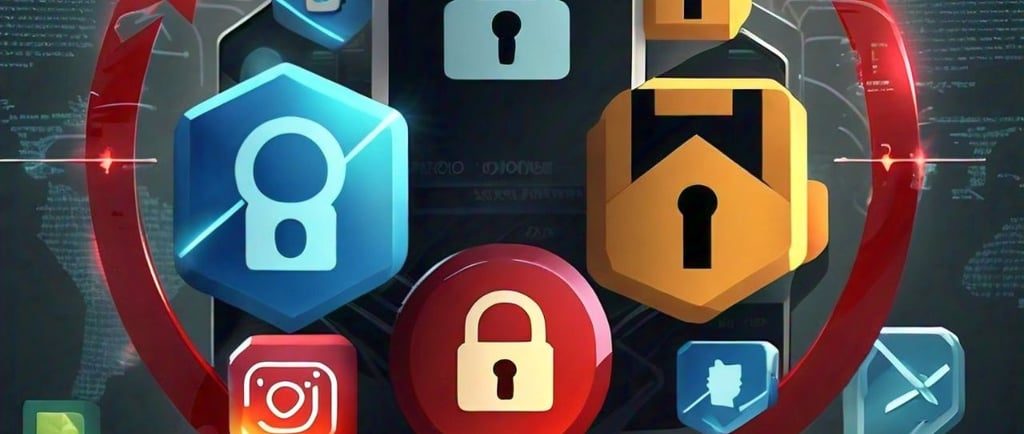Mastering Social Media Security: Techniques for Effective Handling and Setting Up MFA
CYBERSECURITY


Understanding the Importance of Social Media Security
In an increasingly connected world, the importance of securing social media accounts cannot be overstated. With billions of users sharing personal and professional information online, these platforms have become prime targets for cybercriminals. Common threats such as hacking, phishing, and identity theft pose significant risks that can impact individuals and businesses alike. The consequences of these threats can range from lost personal data to severe financial implications for organizations, underscoring the urgent need for robust social media security measures.
Hacking involves unauthorized access to accounts, often resulting in malicious activities such as spreading misinformation or disseminating harmful content. Phishing attacks, which typically come in the form of deceptive messages, can trick users into providing sensitive information like passwords or financial details. Additionally, identity theft can occur when an individual’s credentials are stolen and misused, leading to fraudulent activities that can tarnish reputations and lead to legal repercussions.
Given these escalating threats, it is imperative to adopt a proactive approach to social media security. One of the most effective methods of safeguarding accounts is by implementing Multi-Factor Authentication (MFA). This technique fortifies security by requiring users to provide multiple forms of verification before gaining access, thereby reducing the likelihood of unauthorized access even if a password is compromised. With MFA in place, the security of social media accounts is significantly enhanced, offering an additional layer of protection against various cyber threats.
Ultimately, developing a solid understanding of social media security and the potential threats that exist is crucial for all users. Being aware of these risks empowers individuals and organizations to take the necessary steps to protect their information and maintain their online integrity. Establishing preventative measures like MFA is not just advisable; it is essential in today's digital landscape.
Techniques for Effective Social Media Handling
To maintain robust security on social media platforms, adopting a systematic approach is essential. One of the first techniques for effective handling is the regular updating of passwords. Users should create complex passwords that combine letters, numbers, and special characters, ensuring they are at least 12-16 characters long. It is advisable to update passwords every few months and to avoid using the same password across multiple accounts. Utilizing a password manager can help in generating and storing unique passwords securely.
Recognizing phishing attempts is another crucial technique. Cybercriminals often deploy phishing tactics to trick users into revealing their login credentials. Training individuals to identify suspicious links, unsolicited messages, or requests for personal information can significantly reduce the risk of unauthorized access. Implementing security measures such as enabling alerts for login attempts from unrecognized devices also enhances security.
Managing privacy settings on social media accounts is paramount. Users should regularly review their privacy settings to ensure that personal information is not publicly accessible and that the audience for their posts is appropriately set. Limiting the information shared publicly minimizes the opportunities for cyber threats.
It is crucial to remain cautious of third-party applications that request access to social media accounts. Users should only authorize applications that are reputable and necessary for their functions. Regularly reviewing authorized applications allows users to revoke access as needed.
For businesses, creating a social media policy is vital. This policy should delineate the responsibilities of team members regarding the management of social media accounts, outlining best practices for maintaining security and ensuring that all employees understand their roles in safeguarding the company’s online presence. Cultivating a culture of vigilance within an organization can further promote effective social media handling by encouraging team members to remain alert and proactive in recognizing potential security threats.
Setting Up Multi-Factor Authentication
Multi-Factor Authentication (MFA) enhances security by requiring users to provide two or more verification factors to access their social media accounts. This section will guide you through the steps necessary to enable MFA on popular platforms such as Facebook, WhatsApp, Instagram, and Twitter. Each subsection will cover specific requirements along with options for authentication methods, enabling a comprehensive understanding of this critical security feature.
To enable MFA on Facebook, follow these steps:
1. Log into your Facebook account and navigate to 'Settings & Privacy.'
2. Click on 'Settings' and select 'Security and Login.'
3. Under the 'Two-Factor Authentication' section, click 'Edit.'
4. You will be prompted to select your preferred method of authentication. Options typically include 'Text message' (SMS) or 'Authentication app.'
5. Once selected, follow the on-screen instructions to complete the setup.
WhatsApp currently supports two-step verification rather than traditional MFA, but it significantly enhances account security.
To enable it:1. Open the app and go to 'Settings.'
2. Tap on 'Account,' then select 'Two-step verification.'
3. Click 'Enable' and set a six-digit PIN, along with an email address for recovery purposes. This two-step verification adds an extra layer of security against unauthorized access.
To set up MFA on Instagram:
1. Access your profile, tap on the three lines in the upper right corner, and select 'Settings.'
2. From there, go to 'Security' and tap 'Two-Factor Authentication.'
3. Choose your preferred method, either 'Text message' or 'Authentication app,' and proceed to follow the required steps to authenticate your selected option.
For Twitter, setting up MFA is straightforward:
1. Log in and access 'Settings and privacy.'
2. Under 'Security and account access,' find 'Security' and click on 'Two-factor authentication.'
3. Select the method of your choice: 'Text message,' 'Authentication app,' or 'Security key,' and follow the setup prompts.
Overall, activating Multi-Factor Authentication on social media platforms significantly strengthens your account's security. Ensure you keep updated with recent changes related to MFA options on each platform, and in case of issues during setup, refer to the help sections provided by these services for troubleshooting.
Maintaining Your Social Media Security Post-MFA Setup
Implementing Multi-Factor Authentication (MFA) is a significant step toward enhancing social media security; however, the journey does not end there. Once MFA has been set up, users are entrusted with the ongoing responsibility of ensuring their accounts remain secure. Regular monitoring of account activity is essential. Users should routinely check for any unauthorized access attempts or any changes made to their profiles that they did not initiate. Many social media platforms provide tools to view recent logins and session history, making it easier to spot irregular behavior.
Additionally, keeping recovery options updated is crucial in maintaining social media security. Users should regularly verify their recovery email addresses and phone numbers linked to their accounts. This practice plays a pivotal role in ensuring that users can regain access swiftly if they ever need to recover a compromised account. Furthermore, updating these recovery options can prevent unauthorized individuals from succeeding in their attempts to take control of an account.
Periodic reviews of security settings should also be prioritized. Social media platforms frequently update their security features and protocols. Therefore, it is advisable for users to stay informed about these changes and adjust their settings accordingly. For example, enabling additional privacy settings can further safeguard personal information from being accessed by unauthorized parties.
In an ever-evolving digital landscape, staying informed about the latest security trends and updates is vital. Users should follow reputable tech news sources and engage with community forums discussing social media security. This proactive approach helps users adapt their security practices in alignment with new threats or vulnerabilities that may arise. By taking these steps, users not only protect their individual accounts but contribute to a broader culture of security awareness within the social media community.
